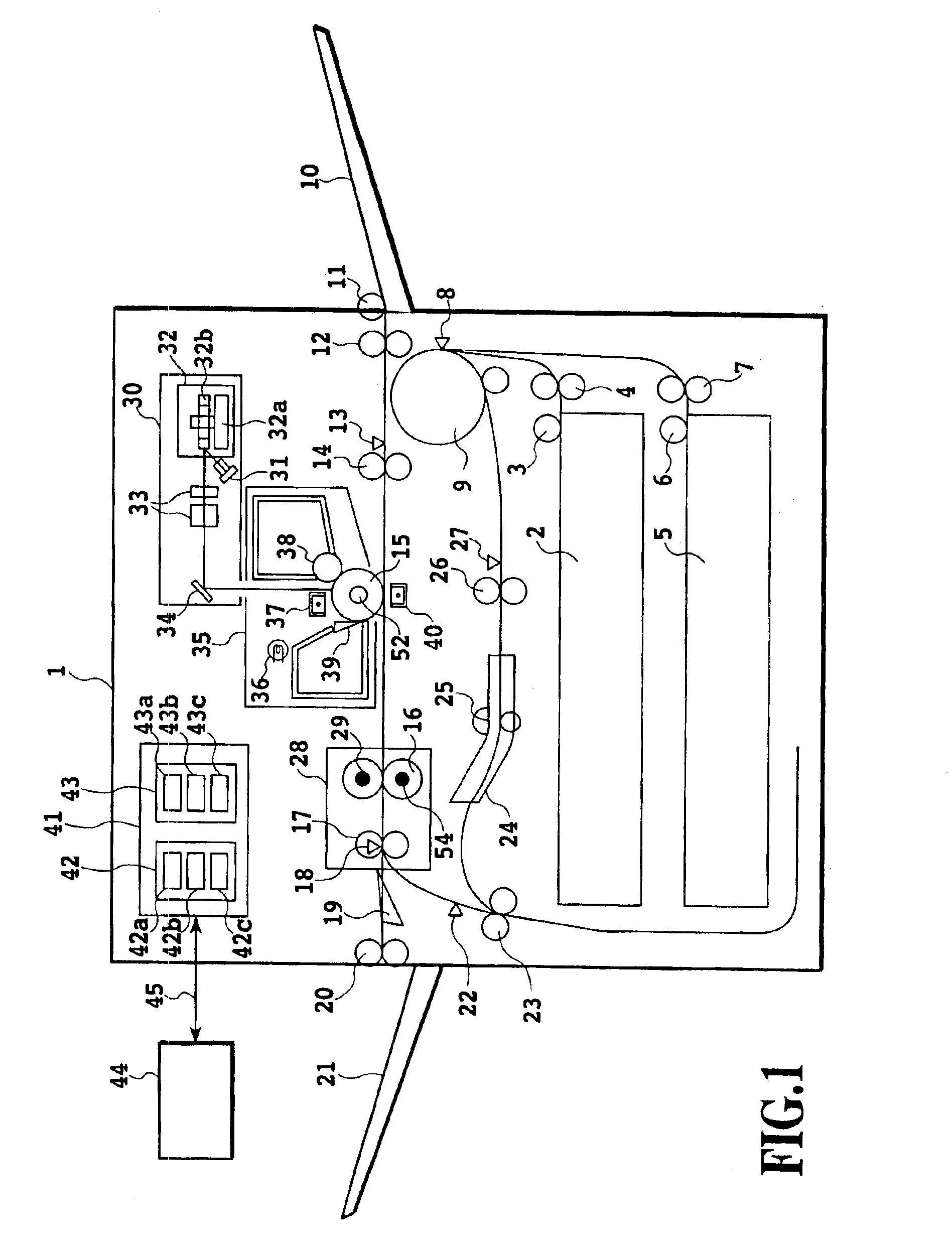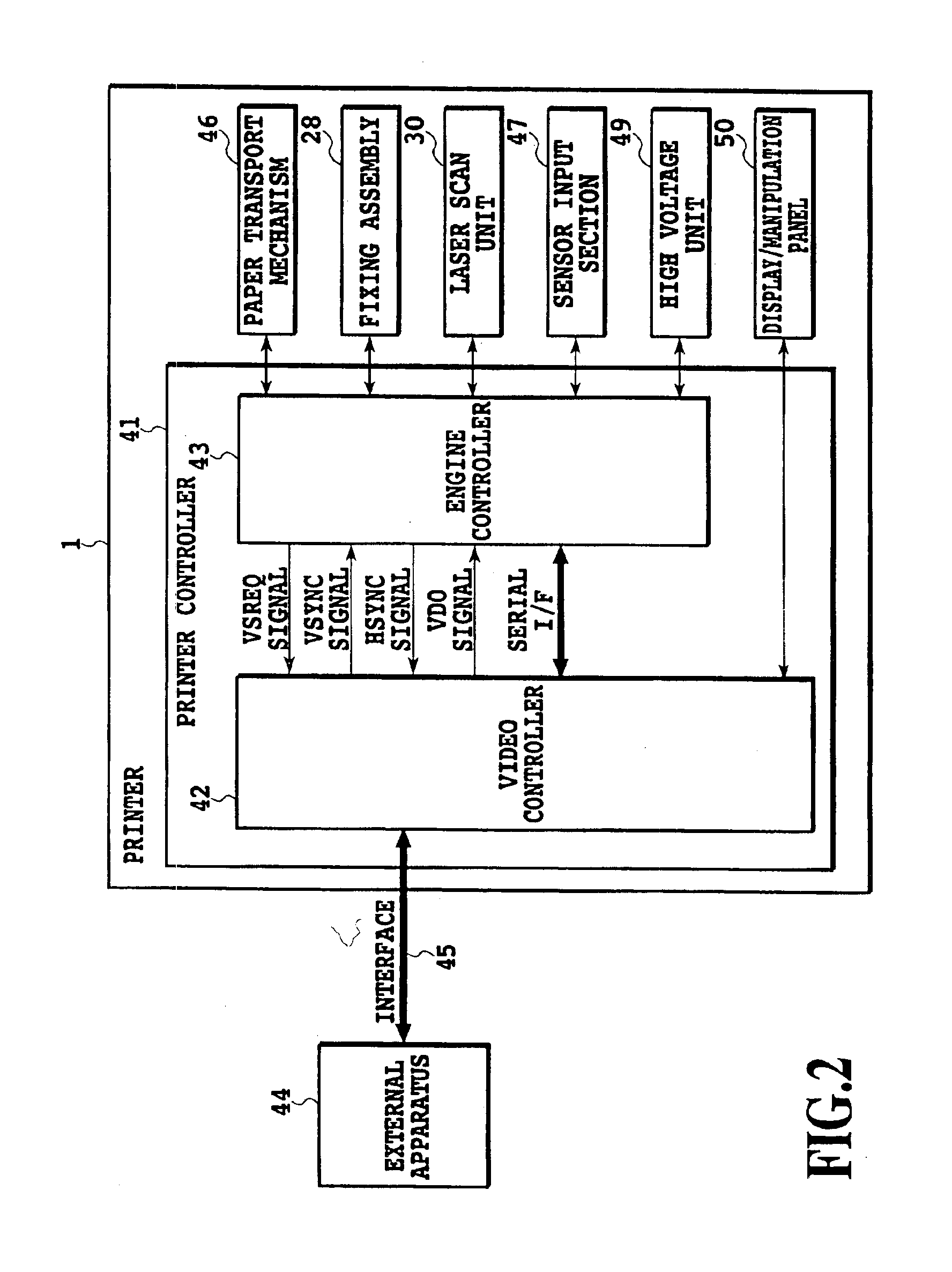Printing apparatus
a printing machine and printing technology, applied in the field of printing machines, can solve the problems of prolonging the time of paper transport, changing the page sequence, and unable to change the order of pages, so as to prolong the life of the fixing assembly, reduce the duration of the rotation of the fixing roller, and optimize the printing sequence
- Summary
- Abstract
- Description
- Claims
- Application Information
AI Technical Summary
Benefits of technology
Problems solved by technology
Method used
Image
Examples
embodiment 1
(Embodiment 1)
[0056]FIG. 1 is a front view showing an arrangement of a first embodiment of a printing apparatus in accordance with the present invention by way of example of a laser printer. Incidentally, the present invention is applicable to an image formation apparatus using an intermediate or color image formation apparatus. The present invention is also applicable to printing apparatus that form images by the electrophotographic process such as printers besides copiers.
[0057]The main body 1 of the printer includes an upper cassette 2 and a lower cassette 5 for holding recording media. A recording medium is sent out from the upper cassette 2 by an upper pickup feed roller 3, and is conveyed by upper transport rollers 4. In addition, another recording medium is sent out from the lower cassette 5 by a lower pickup feed roller 6, and is conveyed by lower transport rollers 7. The recording medium sent out from the upper cassette 2 or lower cassette 5 is detected by a downstream feed...
second embodiment
[0112]FIG. 11 is a front view showing an arrangement of a second embodiment of the printing apparatus in accordance with the present invention. The second embodiment differs from the first embodiment in the construction of the fixing assembly 28, and hence the description of the same portions as those of the first embodiment will be omitted here. The fixing assembly 28 is a film heating type fixing device, which comprises a heating-pressurizing roller assembly 16 including a heating film and pressurizing roller and a heater 29 consisting of a ceramic heater installed within the heating film.
[0113]A temperature detector not shown is put into contact with the surface of the ceramic heater to control the surface temperature of the heating film at constant by turning on and off the heater in response to the detected result of the temperature. As for the film heating type fixing device, since it is the same as that disclosed in Japanese Patent Application Laid-open No. 9-146391 (1997), t...
third embodiment
[0121]Since a view showing an arrangement of the third embodiment of the printing apparatus in accordance with the present invention is the same as FIG. 1, the description thereof is omitted here. In addition, since a functional block diagram showing a configuration of the image recording unit associated with the first embodiment in accordance with the present invention is the same as FIG. 2, the description thereof is omitted here. The third embodiment differs from the first embodiment in that in the paper transport mechanism 46, the photoconductive drum and the fixing pressurizing rollers are driven by independent driving sources to make them rotatable individually of each other without interference. Incidentally, although the photoconductive drum driving motor 52 and heating-pressurizing roller driving motor 54 are shown in FIG. 1 as the independent driving sources, one of the photoconductive drum and fixing pressurizing rollers can be driven by using a single motor and clutches....
PUM
 Login to View More
Login to View More Abstract
Description
Claims
Application Information
 Login to View More
Login to View More - R&D
- Intellectual Property
- Life Sciences
- Materials
- Tech Scout
- Unparalleled Data Quality
- Higher Quality Content
- 60% Fewer Hallucinations
Browse by: Latest US Patents, China's latest patents, Technical Efficacy Thesaurus, Application Domain, Technology Topic, Popular Technical Reports.
© 2025 PatSnap. All rights reserved.Legal|Privacy policy|Modern Slavery Act Transparency Statement|Sitemap|About US| Contact US: help@patsnap.com



